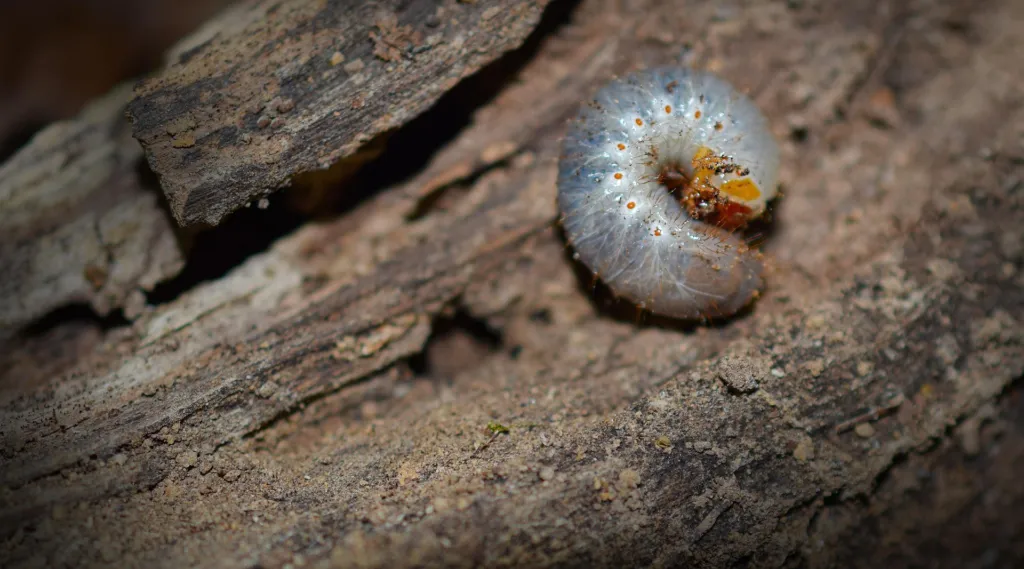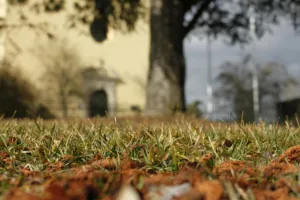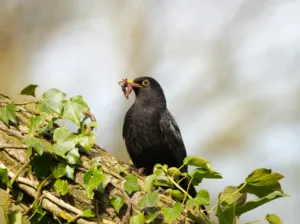
5 Clear Signs of Grub Damage In Your Lawn
Learn to Identify & Eliminate Destructive Beetles in Midwestern Yards
Sponginess or unexplained brown patches on your grass can actually be due to something beneath the surface. Pesky little grubs. Grub damage to lawns in the Midwest can happen quickly and silently.
That’s why we’re providing expert-recommended methods for eradication and long-term control. Plus, we’re sharing the five signs of grub damage you absolutely need to know.
Lawn Grubs: What Are They?
In the Midwest, grubs are the larval stage of several beetle species, such as European chafers, Japanese beetles, and June bugs. These pests live underground and eat grass and other plant roots.
But what do grubs look like? Spot one and you won’t forget it. That’s because grubs often contrast with the soil they’re in. In other words, these white, C-shaped worms stand out.
During the summer, adult beetles prefer moist, well-irrigated lawns to lay their eggs in the ground. After hatching, eggs become grubs, which start eating grass roots right away.
When cooler or freezing temperatures arrive, grubs overwinter by digging deeper into the ground. Then the cycle restarts. Grubs come back to the surface to feed once more before developing into adult beetles.
Midwestern states in the U.S. can see damage from grubs until early fall. That’s why it’s important, especially this time of year, to know what grub lawn damage looks like.

5 Signs of a Serious Lawn Grub Problem
1. Actual Grubs in the Soil
Pick an area that seems suspect, especially one with spongy or brown grass. Cut a patch that’s one foot square. Remove a small piece of turf, about two to three inches deep, and examine it for C-shaped, white larvae.
2. Brown, Thinning Patches
The grass may turn brown and die in asymmetrical patches as a result of grubs feeding on the roots. This usually begins in late summer or early autumn. It frequently resembles fungal or drought problems. Just keep in mind that if grubs are the problem, watering won’t help your grass return to normal.
3. Spongy or Loose Grass Underfoot
You know how those grubs were eating your grass roots? Another issue with that is damaged grass lifting easily like a loose carpet because the roots have been eaten away. In other words, if your grass “rolls back” without much effort, grubs could be the culprit.
4. More Animal Activity
Additional damage is done when raccoons, moles, skunks, and birds dig up lawns to eat grubs. Signs of this? Holes the size of pencils or soil that’s been turned over.
5. Beetles or Moths at Dusk
A new generation of root-eating grubs will hatch from the eggs that these adults are actively laying in the soil of your healthy turf. Have you seen flying insects near your yard? If so, a destructive grub infestation may be lurking beneath the surface.
Tips for Treating Lawn Grubs in the Midwest
Natural/Organic Options
Grub growth is inhibited by neem oil, a natural insecticide. However, it’s best used if you only have a minor infestation.
Japanese beetle grubs are the specific target of the bacterium known as milky spore. It offers long-term control but takes one to three years to set up. Plus, it’s okay to use if you have pets.
Did you know that grubs can be parasitized and killed by microscopic worms called beneficial nematodes? When the soil is warm (above 60 degrees Fahrenheit) in the spring or early fall, they perform best. Remember that for maximum effectiveness, they require moist soil.
Lastly, try manual removal using a wet burlap sack. Place the soaked cloth on the damaged lawn overnight. The heat and trapped moisture will attract grubs to the surface, enabling you to gather and get rid of them in the morning.
Chemical Treatments
The best course of action for proactive defense is to use preventive insecticides. To establish a protective layer in the soil, these are best applied in the early summer, right before or as beetle eggs are hatching. The young, freshly hatched grubs consume the insecticide as they start feeding and die before they have a chance to seriously harm the roots of your lawn.
Already too late for this step? A curative insecticide is needed when an active infestation is currently causing noticeable damage. These products kill grubs on contact and are most effective when used in late summer or early fall.
In order to guarantee that the product penetrates the soil and reaches the pests, it’s essential to water after application. Apply these treatments in the early morning or evening when bee activity is low, so you safeguard pollinators.
Finally, don’t forget to look for ingredients like chlorantraniliprole for a longer-lasting residual effect in the soil or bifenthrin for a rapid pest knockdown.
When Do Grub Treatments Work Best?
The timing of any curative grub treatment is crucial to its effectiveness and depends on your exact location. Applications should be made 10 to 21 days after a discernible increase in adult beetle or moth activity. Why? This activity suggests egg-laying happened recently, so it gives you a better chance at high-quality results.
Grubs are targeted in their earliest, most vulnerable stages by this calculated timing, before they have a chance to seriously harm roots. After an application, the area should be closely watched. If grub activity continues for more than two weeks, a follow-up treatment might be required to get total control.
Preventing Grub Infestations In the Future
Lawn Maintenance Best Practices
- Aerate and dethatch yearly. This keeps the soil from becoming compacted and offers fewer food sources to these hungry pests.
- Mow at a higher height. Scalping your yard weakens the grass, making it easier for grubs to take over. Grass should be about 3-4 inches tall.
- Don’t overwater. Grubs love moist soil. Watering when beetles lay their eggs encourages their survival.
Preventative Grub Control
Curative grub treatments are handy if you currently have an infestation since they can be used later and with more immediate results. However, if you can, try to get ahead of the curve. Here are some quick tips about applying pre-emergent insecticide based on where you live.
Midwest & Northern U.S. In order to target grubs later in the season (August and September), you should treat your lawn from late July to early September.
Gulf Coast & Southern U.S. Since the season lasts from May to October and there’s a chance that generations (and species) will overlap, start treatments earlier and keep an eye on things for longer.
Stay vigilant! Watch out for beetle activity every summer and fall because pressure and population levels can fluctuate from year to year.
Also, keep in mind that severe cases may need a follow-up. To break the grub damage cycle, a proactive second application the following season is strongly advised if the infestation was bad.

Is It Grubs In Your Lawn or Something Else?
It can sometimes be difficult to tell the difference between grub damage and other issues. Here are three other possible causes and how to rule them out.
Pet Urine: Rather than peeling up like a carpet, which grubs can cause grass to do, damage from pet urine typically manifests as a central green patch (from nitrogen) encircled by a ring of dead grass.
Fungus: Grub damage manifests as irregular, dispersed brown patches. Fungal patches, on the other hand, frequently have recognizable rings or patterns. So pay attention to the shape and regularity of the damage.
Drought Stress: While drought-stressed grass usually greens up again, grub-damaged grass will not recover with adequate watering.
Get Those Grubs Today!
What works best for stopping grub damage? Proactive grub management! Early detection protects the health of your lawn while also saving a substantial amount of time and money. After all, extensive repair and restoration are always more expensive than prevention.
Remember that every yard is different, so call your local pest control experts at Kapp’s Green Lawn to get the best care for your lawn. We proudly serve communities in the Midwest, ensuring high-quality lawn care services in these areas:
- Cleveland, OH
- Fort Wayne, IN
- Indianapolis, IN
- Pittsburgh, PA (eastern)
- Pittsburgh, PA (western)
- St. Louis, MO
